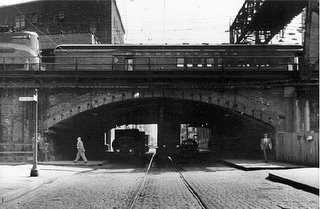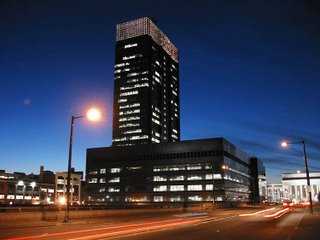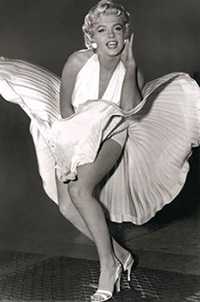Related Topics
North of Market
The term once referred to the Quaker district along Arch Street, and then to a larger district that had its heyday after the Civil War, industrialized, declined, and is now our worst urban problem area.
Particular Sights to See:Center City
Taxi drivers tell tourists that Center City is a "shining city on a hill". During the Industrial Era, the city almost urbanized out to the county line, and then retreated. Right now, the urban center is surrounded by a semi-deserted ring of former factories.
Chinese Canyons

|
| Chinese Wall |
Until well after the Second World War, the entire western side of city hall was facing the Pennsylvania RailRoad . An enormous rambling smoke-stained Broad Street Station squatted right across the street, and westward behind it to 30th Station stretched -- the Chinese Wall. The railroad tracks were elevated forty feet above street level, resting on top of a very wide brick wall with openings at each cross street allowing traffic to go under the tracks. It was dark, dirty, gloomy and hard to ignore, and the tunnels at each cross street were even darker. They had a tendency to drip water on the sidewalks. Whether these tunnels were a place for crime to take place is not certain, but it looked as though that would be true since an army of panhandlers and stumble-bums reinforced the impression by keeping out of the rain under there.

|
| JFK BLVD |
Consequently, the two streets which paralleled the Chinese Wall (Market Street, West, and Pennsylvania Avenue) were lined with dubious structures housing questionable businesses. After the War, Broad Street Station was torn down, the Chinese Wall of train tracks was removed, and it suddenly became clear that City Hall was now approached by two wide boulevards stretching west, with the handsome classical 30th Street Station framed in the center of one of them, renamed JFK BLVD. High rise buildings were built in large numbers along both sides of the two boulevards in what now are four parallel rows, twelve blocks long. Because these buildings were put up under the gentleman's agreement that City Hall would be the height limit, Philadelphia avoided the dark canyon effect so depressingly present in the Wall Street financial district of New York City. However, the two boulevards do not escape the Marilyn Monroe effect.

|
| Marilyn Monroe skirts |
Named after a famous movie scene in which that actress had her skirts blown upward in public, the phenomenon usually has to be explained to newcomers. Winds blowing against the tall face of the buildings are blocked and scoot down to the sidewalk along the side of the buildings. When they reach the ground they have no direction to go but up again. Billowing skirts are in reality not particularly noticeable, but these two stretches of the street usually are windy, and in mid-winter, it is bitterly uncomfortable to walk there. Because rentals are high, these new high-rise buildings are too expensive for the small stores and merchants to set up their shops on the first floor, so almost no one is on the street except those in a hurry to get somewhere else. After five o'clock, these commercial centers are totally deserted and quite forbidding.
One response has been to go underground. The Market Street subway goes underground the whole length of Market West, paralleled by a "subway-surface line", which is to say, trolley cars. So it has seemed natural to tunnel pedestrian walkways along with the basement level of Market Street, and little shops have tended to find a place there, although when commuter traffic declines, they turn out the lights and pull down the steel shutters. It's a nice place to duck out of the rain (and wind), but Philadelphia isn't Montreal or Minneapolis, with tons of snow to drive people underground. Long before the 9/11 tragedy, Wall Street's financial district was deserted at night, too, so this is a generic problem of skyscraper districts, waiting for somebody to suggest a solution. In a way, New York's Park Avenue suggests that when you are moving railroads underground in a city, apartment houses may make for a better new neighborhood than office buildings do.
But such reflections are part of what is called Philadelphia's inferiority complex. Let's face it, the renovation of the Market Street West project is a vast, vast improvement over the mess that was there for a century. It's a success, right?
Originally published: Monday, June 26, 2006; most-recently modified: Wednesday, May 15, 2019
| Posted by: [none] | Oct 23, 2008 7:08 PM |
| Posted by: Charles Jones | May 2, 2007 8:51 PM |